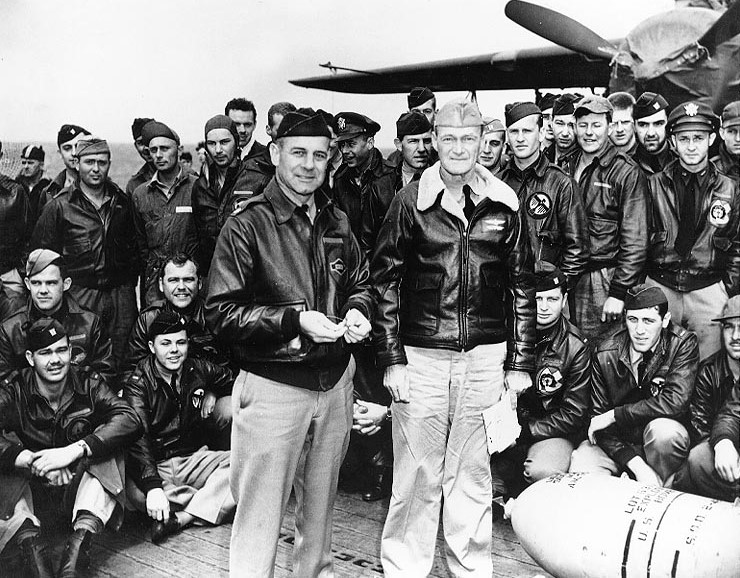Both Army and Navy planners went into high gear. Three weeks later, a navy captain proposed launching Army twin-engine bombers from a navy aircraft carrier. The question became: which bomber? The two services considered the B-18, an obsolescent medium bomber, its successor the B-23 Dragon, the Martin B-26 Marauder and the B-25B. The B-25B, though untried in battle, met the requirements best.
Even so, the B-25 needed extensive engineering modifications to meet the range and bomb load requirements for the mission.
February 3rd, 1942, two B-25's successfully flew from the flight deck of USS Hornet (CV-8). It was not quite two months since Pearl Harbor.
Less than a month later, two dozen crews and modified aircraft began three weeks' intensive training in simulated carrier deck takeoffs, low-level and night flying, low-altitude bombing and over-water navigation. This training in itself was a major accomplishment. When the 22 remaining aircraft flew to California, it had been three months since President Roosevelt charged the Joint Chiefs of Staff with the mission.
In the meantime, USS Hornet was preparing for a voyage halfway around the world, into hostile waters.
Hornet left Norfolk March 4 for the Panama Canal and then on to Pearl Harbor to join Yorktown, Saratoga and Enterprise in the Pacific. Her immediate orders were to head to San Diego. She arrived on March 20, mooring at the carrier berth on North Island. She had steamed more than 6,000 nautical miles from Norfolk.
Preparing for combat, Hornet's Air Group 8 squadrons were provided with upgraded aircraft. Fighting 8 (VF-8) received the F4F-4 Wildcat. Bombing 8 (VB-8) and Scouting 8 (VS-8) received the SBD-3 Dauntless. Torpedo 8 (VT-8) remained stuck with the antiquated TBD-1 Devastator due to a delay in the delivery of the new TBF-1 Avenger. Hornet spent the next week qualifying the pilots for carrier launches and landings.
On March 28, Hornet tied up at North Island again to give her crew a final weekend of liberty in the US mainland. Captain Mitscher received a new set of Top Secret orders that would take the brand new ship on a very circuitous route to Pearl Harbor. Two days later Hornet sailed north, heading towards Alameda Naval Air Station, where she arrived on March 31 and moored at pier 2.
The Doolittle Raid
Meanwhile, twenty-two USAAF B-25 Mitchell bombers arrived at Alameda. On March 31 and April 1, with Hornet’s aircraft stored in the hangar deck, sixteen of the bombers were craned aboard and tethered to the flight deck. Shortly thereafter, 134 Army pilots and aircrew, led by LtCol Jimmy Doolittle, boarded the ship and Hornet slipped out to a mooring in SF Bay to spend the night. At mid-morning on April 2, Hornet and her escorts (Task Force 16.2) steamed under the Golden Gate Bridge, beginning the legendary mission known as the Doolittle Raid.

It was less than four months since the attack on Pearl Harbor.
Two dozen aircraft had been re-engineered.
Two dozen Army air crews had been trained in new techniques.
A brand new aircraft carrier (USS Hornet) had changed from one ocean to another, loaded newly delivered modern aircraft, qualified pilots and aircrew to operate from the new aircraft carrier.
16 B-25's were tied down on the flight deck of a ship for which they were not designed.
The sixteen Army air crews had never taken off from an aircraft carrier.
It would be five thousand miles before Hornet would reach the launch point.





No comments:
Post a Comment